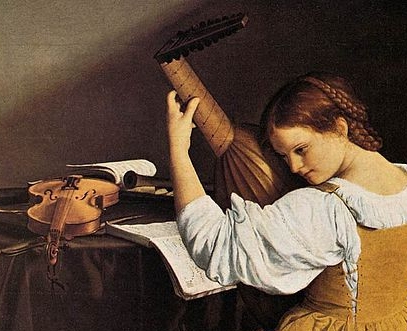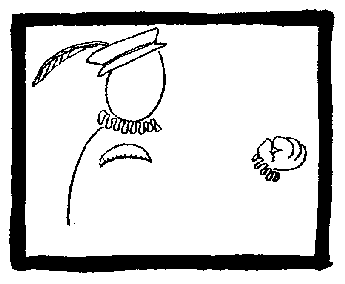Generally overlooked by modern music historians, the Air Lute has faded from view since its heyday as the preeminent intangible instrument of the Renaissance. It is unfortunate that the instrument and its repertoire remain largely unnoticed today.
The Beginnings
Air Lute performance arose in Europe after the introductions from the East of the Ud, a stringed instrument with 6 courses of strings and no frets, and the concept of numeric zero. Revolutionizing first mathematics and then music, it was only a matter of time before they merged to produce the Air Ud.
As opposed to the finger plucking technique later developed for Air Lute, the Air Ud was played with a simple, illusory plectrum. Demand for invisible feathers as picks brought several mythical bird populations to near extinction level.
With the dawning of the Renaissance, the unfocused expression on the face of music changed. Just as the Mediterranean Ud had earlier been adapted into the European Lute, the Air Ud metamorphosed into the Air Lute.
An Air Ud could be very quickly and easily converted to an Air Lute, and at virtually no cost, unfortunately leading to the impoverishment of most Air Luthiers. Perhaps also as a result, no Air Uds have survived from that period. This has lead to speculation that Air Ud may never have existed in the first place, which is an absurd statement any way you look at it.
Modern descendants of Air Ud are still played throughout the Middle East and wherever quality hashish is served.
The Air Lute Winds Its Way Across Europe
In nothing flat, the Air Lute became a favored instrument across Europe, where it was known by many names.
In Spain it was called the “vihuela de nada.”
In the area that is now Israel, they were apparently called “Air Jordans,” although research into etymological veracity is still afoot.
In the Netherlands, where the Lute had a strong sexual connotation owing to the fact that “lute” also meant “vagina,” the initial “a” in Air Lute was strongly aspirated to produce “Hair Lute.” This was considered wonderfully naughty and consequently very funny by the Lowlanders, who didn’t get out much.
While Air Lute offered many advantages over the Actual Lute, the most desirous may have been the elimination of endless tuning. Like a Venetian courtesan during Carnevale, the Air Lute was always ready to go.
Because of its near indestructibility and ease of transport with regard to space and weight considerations, all noblemen carried their Air Lutes with their entourage at all times. This, combined with the ease and speed with which most could master the Air Lute (its a breeze, there’s practically nothing to it), helped make it the most popular and expressive instrument of all, sometimes called the “Virgin Queen of Imaginary Instruments.” Virgin, of course, because it has never been plucked.
The Technique
With the increasing complexity of music for Air Lute, a new finger plucking method developed employing the thumb and the first three fingers of the right hand.
Owing to the relaxed nature of Air Lute, which had no soundboard to use as an anchor, the pinky finger and even the elbow were occasionally employed for added artistic expression.
The basic technique involves stroking and plucking the hypothetical strings with the right hand, accompanied with an often whimsical movement of the fingers of the left hand.
The best Air Lute performances are accompanied by music from another source. Nobles would generally perform to the music of actual lutes, while peasants often had to make do with howls of stray cats outside their hovels.
Complaints by Real Lutenists of the fitful temperament of their strings and the difficulty of tuning would often fall on unsympathetic ears, since tuning gut is measurably more tricky and dangerous while still inside the cat.
Ornamentation
The earliest documented ornament is the “squint.” It involves a tightening of the face around the eyes suggesting either an attitude of concentration, flights of musical inspiration, or a precipitous onset of dysentery.
Another crowd-pleasing flourish was the “nodding dashboard ornament,” or N.D.O., wherein the head is bobbed in time with the music. Most dramatic when executed with luxurious tresses, this ornament brought an influx of weavers from what is now Iran. They created a special hairpiece for Air Lutenists who were follicly challenged, dubbing it the “Persian rug.”
With the “grimaccio d’amore” (from the fake Italian), the teeth were bared as if in great anger. Due to substandard dentistry, many avoided this flourish in the daytime, preferring the “protruding tongue of St. Edmund.”
The squint, N.D.O., and the grimaccio d’amore were sometimes combined for especially difficult passages or to frighten off vexacious neighborhood children.
Contrary to popular belief, the “flaming tongue” ornament was not used in period. It was conceived circa 1913, when pioneering air guitarist Andres Segovia employed it before packed audiences of swooning señoritas in Seville. This ornament proved so potent that it made the transition from Air Guitar to Actual Guitar and then to So-Real-You-Can-Trash-a-Hotel-Room-With-It Electric Guitar.
Other Air Instruments
Air Wind instruments with few exceptions (see Air Sackbut below) were scorned by genteel company. It seems that having “air” and “wind instrument” together in the description was too tastelessly evocative of cutting the cheese.
While lute was the undisputed leader among apocryphal instruments for solo work, the Air Viola da Gamba (or simply Air Viol) was the favorite for consort music with imaginary friends.
Air Viol was gripped between the knees in a manner similar to the modern Air Cello, although with no imaginary end pin. This made the Air Viol more tiring to play, especially so for hypochondriacs.
After almost a century of great popularity, Air Viol began to lose ground to Air Violin following a shift from intimate settings to larger venues for musical performance. Since Air Violin could be played standing and even while walking about, it allowed musicians greater mobility and unfettered buffet access.
Ambulation with an Air Viol nestled between the knees was a tricky business. Attempts resulted in several arrests for indecency and at least one impromptu proposal of marriage.
The death knell for the Air Viol sounded when the 17th Earl of Presley introduced the “pelvic thrust.” Performing this lusty ornament while scissor-holding an imaginary viol caused the instrument to shoot out like a watermelon seed and shatter into countless insubstantial pieces.
Once imagined, the Air Sackbut became and has remained an unlikely but compelling force in the nonrealistic music world. While exact reasons for its continued popularity remain conjectural, simplicity of performance has gained traction among academic circles and Nordic drinking societies.
Playing Air Sackbut involves constant movement of the slide from first position to sixth position and back again, ad infinitum, and the only ornament ever used is the “dancing eyebrow.”
The Demise of the Air Lute
It was clear that the Air Lute was disappearing from the musical landscape. Changes and improvements in musical instruments over time continued to render instruments obsolete. In the 17th century, for example, the Air Dulcian was replaced by the Air Fagott Horn to general merriment.
Almost alone in his admiration for “der Luft Lute”, Johann Sebastian Bach wrote some of the last works for the instrument. The most famous (and precisely named) being “Air for the G String.”
In the late 19th century, philosopher Friedrich Nietzsche gave a rare nod of approval to the Air Lute. Citing it as the very personification of skepticism and the arbitrary nature of existence, Nietzsche called it “der Katzenstiller Meowen des Nichts,” or “the silent cat’s song of nothingness,” which is Teutonic slang for “kinda like nihilism.”
In the early years of the 20th century, Air Classical Guitar completely displaced the Air Lute, evolving into the preferred hypothetical pluckaphone for musical performance. With only a brief surge of popularity due to the movie “Deliverance,” Air Banjo never had a chance.
Whether or not Air Lute will make a modern reappearance literally remains to be seen.
Exciting New Innovations
The ongoing invention of new real instruments inevitably leads to the creation of new fictional instruments. One recent invention is Virtual Midi Keyboard, reiteratively removed from reality by reason of being a nonexistent instrument used to imitate other nonexistent instruments.
Most exciting of all is a revolutionary hybrid instrument introduced in the movie “Tous les Matins du Monde.” (English title: “All the Matinees are on Monday”) The actor playing Ste. Colombe has pioneered a new area of pseudo-musical endeavor. Essentially playing Air Viol, he does so while actually holding a viol and bow! His mastery of avante garde Air Viol technique is demonstrated when fingers and bow do not move with the music, and fretting occurs with an inspired disregard for verisimilitude.
Such a provocative new concept cries out for Air Lute application, perhaps in a big budget bio-pic about John Dowland. Master Dowland was a preeminent composer, noted lutenist and thwarted sycophant to Queen Elizabeth. His composition, the melancholy masterpiece “Flow My Tears,” was the late 16th century equivalent of “Stairway to Heaven.”
Conclusion
The study of Air Lutes is a challenging one fraught with unforeseen, and indeed, unseeable, difficulties.
Reconstruction of technique is problematic at best. Study of the instruments, especially with an eye to historically-informed reproductions, is made exceeding difficult by two problems.
Firstly, but not surprisingly, there is absolutely no iconographic evidence of any kind. No paintings, no sculpture, no drawings. Zip.
Secondly, the unavailability of Air Lutes in museum collections is distressing. At every occasion when I find myself at an exhibition of early instruments, Air Lutes are represented by an empty stand bearing the note “Temporarily Unavailable for Viewing.”


